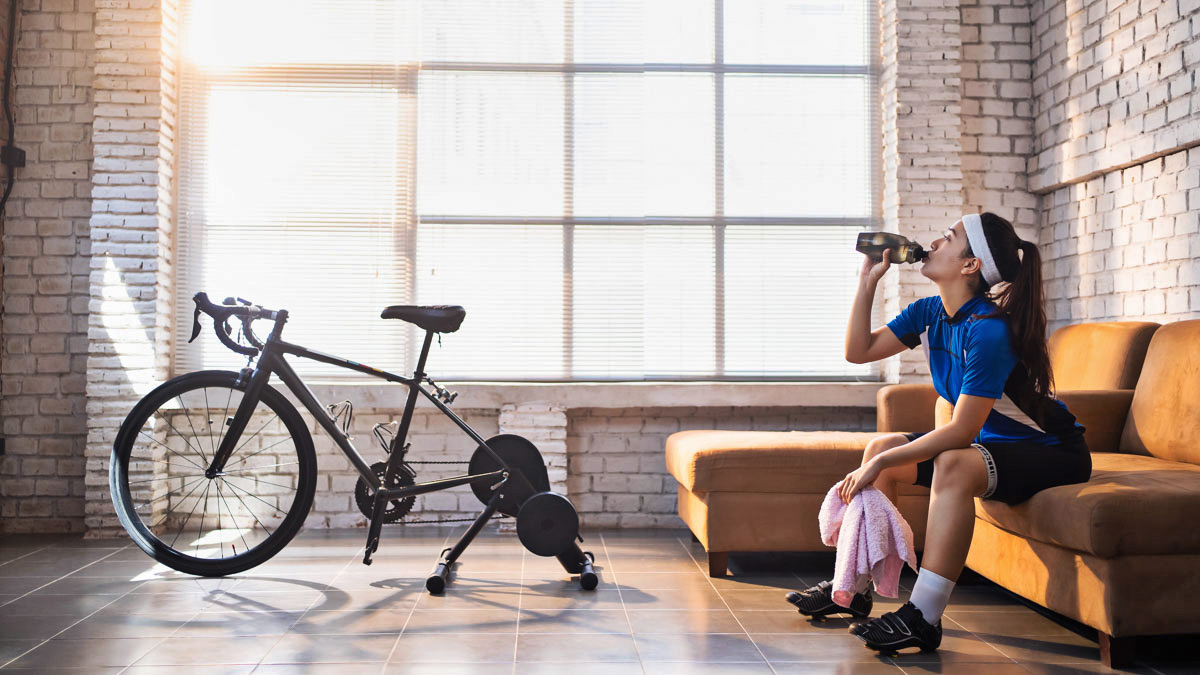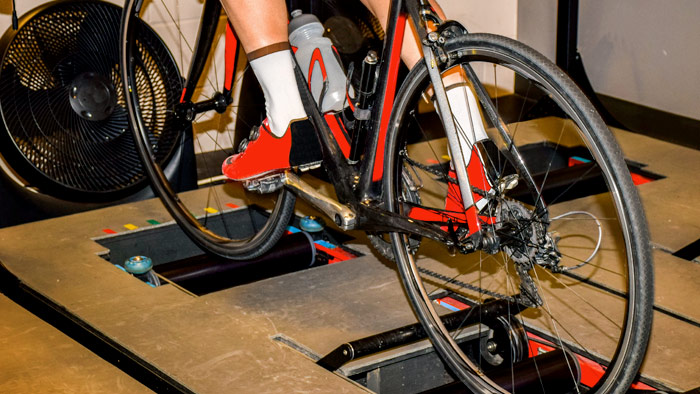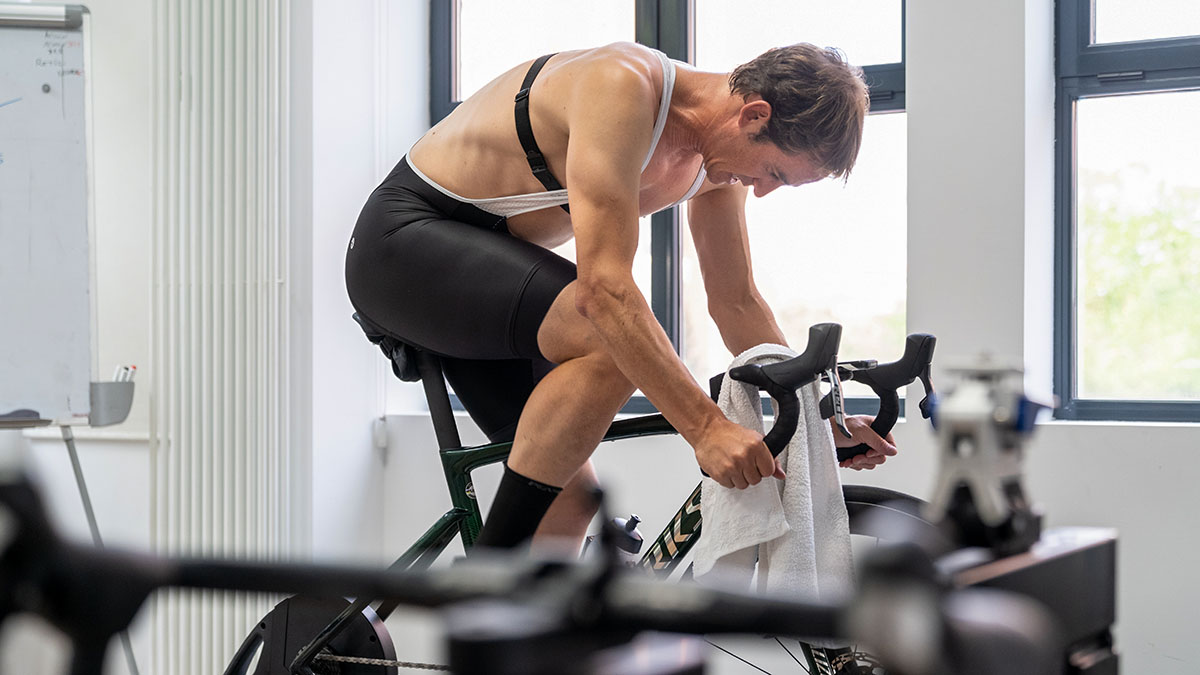It wasn’t too long ago that indoor training was seen as the work of the devil; a synapse-sizzling, mind-numbing way to improve your cycling. Then indoor-trainer manufacturers and software developers got smart, and the landscape changed. Now, the likes of Wahoo, Tacx and Elite are common in most cyclists’ and triathletes’ garages/spare bedroom/main bedroom (delete as applicable). Thanks to wireless syncing, where once you rode staring at a wall, now you can race someone on the other side of the world. That hint of competition raises motivation and the value of your workout.
Zwift is the market leader, and Covid has helped send their user numbers through the roof, but they’re not the only ones. Virtual cycling app RGT Cycling did a year’s worth of business in 10 spring lockdown days, while thousands also flock to the likes of TrainerRoad, Sufferfest and Rouvy.
Indoor training is turning into a sport in its own right, which is why it’s important to nail your nutrition and hydration strategy at home. It’s a double win because refining your fueling protocol indoors will pay off when you ride outdoors.
Find your Sweat Rate
When you’re working up a sweat indoors, you don’t enjoy that cooling wind (a fan helps but still isn’t up there with air resistance), so it can become hot. Very hot. As such, a meticulous hydration strategy is arguably of greater importance than when you’re training outside.
This is where a sweat test comes in. Simply measure your nude bodyweight before and after a hard 60-minute session on Zwift or similar. One kilogram’s roughly the equivalent of one liter, so if you lose 0.75kg over an hour’s of effort, your fluid intake during the session should be around 750ml, though it’s not essential if you don’t drink all of this.
You might question the accuracy of these figures as surely you’re also burning through carbohydrates and fat. Back to Jeukendrup. ‘Most weight lost is water with a small amount of carbohydrate and fat. That said, with longer (more than 3hrs) indoor sessions, it’s possible to lose 500-800g of weight that’s not fluid. Still, weight loss is our best estimate of fluid losses and fluid needs. This doesn’t mean that you must drink so much that your weight is the same when you finish a workout. If you lose 3% of your bodyweight and some of that is carbohydrate or fat, that should be no problem at all.’
Increase Your Carbohydrate Intake
If you’re riding for over an hour, look to consume around 60g of carbohydrates per hour from whichever source you feel comfortable with. As an example, this might be some energy drink plus two gels. Like your muscles, it’s possible to train your gut to consume more carbohydrates and keep your furnace burning harder and longer for a better indoor session.
For insight, we turn to a world leader in this field, Asker Jeukendrup, professor of exercise metabolism and multiple Ironman finisher. Jeukendrup has worked with pro-cycling team Jumbo-Visma, home to Vuelta a España and Tour de France winners. The Dutch professor has also worked with some of the world’s finest soccer teams, including Barcelona. In short, he knows his stuff.
“I’d start with 50grams of carbohydrate per hour and build up to 70g/hr, maybe even 80g/hr,” says Jeukendrup. “If you can tolerate 70g/hr in training, it’s likely that you can tolerate 60g/hr later in your races without any problems. Zwift is a great platform to train this because access to drinks and sports nutrition products is easy, and you can also easily follow a timeline or a plan.”
Practicing your race nutrition plan is a key attribute of Zwift, though the 100-mile-plus riders or triathletes out there might not be too keen to spend that long indoor training. Not a problem, says our Dutch professor. “Few Ironman athletes, for example, are going to ride 112 miles indoors, so you need to challenge the gut in different ways. Slightly higher intensity is a challenge, and slightly higher carbohydrate intake, too, so if you’re not going to be on the bike for 5-6 hours, try to ride at a higher intensity and increase your carbohydrate intake by 10% or so compared with your race nutrition plan. I’d suggest really nailing your nutrition plan from at least 10 weeks out from your race.”
What is the Purpose of Your Session?
Like all fueling recommendations, what you eat or drink comes down to the specific aim of the session and environmental temperature. If your goal’s simply to get those legs spinning, nutrition’s less important than if you’re racing or looking to really get the best from the session.
Duration is also a big factor. The appeal of Zwift and other platforms is to enjoy a pretty high-intensity session over an hour’s riding. This fits in neatly with other facets of life. Then again, many cyclists are happy to pedal away for three hours or more.
“If your indoor session’s longer than 45 minutes, I’d advise a carbohydrate drink with some electrolytes, though the usefulness of electrolytes is debatable,” says Jeukendrup. This might surprise many of you, as electrolytes have become the go-to supplement in recent years. “If the exercise is relatively short, electrolytes have little or no effect. In fact, while there’s a huge amount of hype around electrolytes, there’s not a lot of evidence of their benefits. Yes, we lose them in sweat, but that doesn’t mean we need to replace them immediately during exercise. And not many people would spend that much time on a trainer that they would develop an ‘electrolyte deficiency’.”
The likes of Precision Hydration, sodium experts in the UK who work with a number of top athletes, including American basketball and football teams, would argue otherwise. But Jeukendrup maintains that carbohydrates should be your turn-to, though you might not need to swallow if you’re going hard for an hour.
Mouth Rinsing?
Jeukendrup is also an expert in mouth rinsing with carbohydrates. The idea is that carbohydrate receptors in the mouth send positive signals to three main areas of the brain (the insula/frontal operculum, the orbitofrontal cortex, and the striatum), which are integrated with fatigue signals from the muscle before an appropriate motor output (in other words, less fatigued) is generated.
“It appears that the mouth rinse is most potent during exercise that is all out and lasts around 60 minutes,” says Jeukendrup. You might ask why would you spit instead of swallowing, The idea is that if you’re suffering from gastro distress (rare at this duration), your body can focus on delivering energy to the working muscles rather than expending energy absorbing and assimilating those carbohydrates.
Of course, this is micro-detail, and, says Jeukendrup, sipping is fine, as is consuming gels and solid food, especially if the duration’s well over an hour and there’s little fat, fiber, or protein in your food.
So you’ve utilized indoor training to optimize your hydration and nutrition strategies. Well, there’s one final indoor nutrition benefit before you stop digesting these words and hit your indoor trainer. The lack of airflow and raised temperature can pay dividends if you’re looking to acclimatize for a race in the heat. ‘Simply crank up the heat in your pain cave, and you’ll see a good rise in core temperature, which is what you’re after when preparing to race in the heat,’ says Jeukendrup. ‘Ten sessions of 1-1.5hrs should give you most of the adaptations you need to compete in even the most extreme conditions.’
So there you have it, everything you need to maximize each and every session. Now what are you waiting for? Get pedaling!
References
www.mysportscience.com/post/2020/04/07/zwift-and-my-nutrition-plan
www.mysportscience.com/post/mouth-rinse








